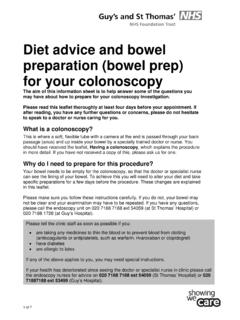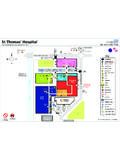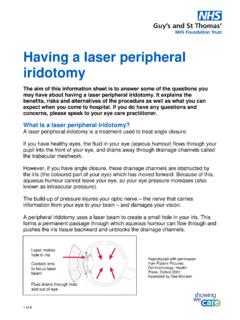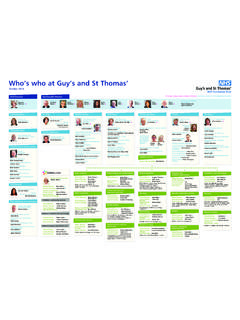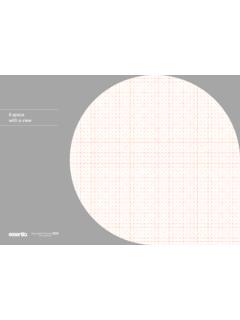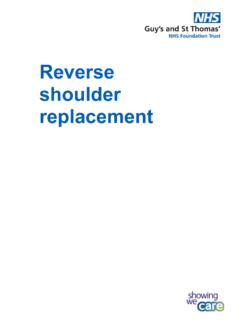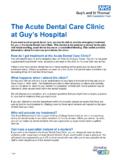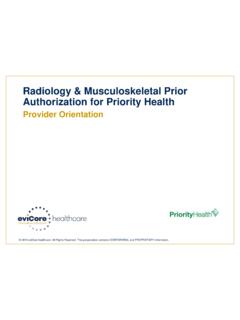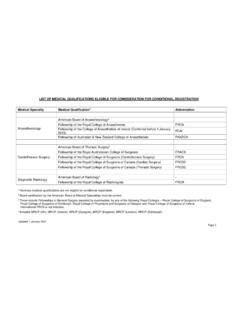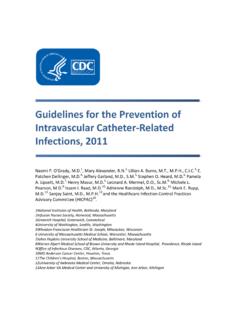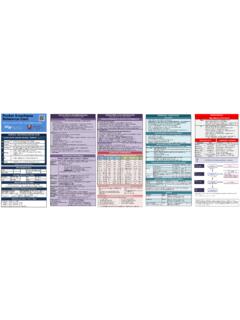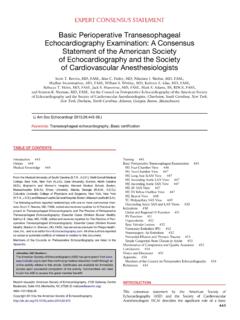Transcription of Thoracic aortic aneurysm - Guy's and St Thomas' NHS ...
1 1 of 6 Thoracic aortic aneurysm This leaflet explains about Thoracic aortic aneurysms. If you have any further questions or concerns, please contact the nurse case managers on 020 7188 1025 / 1085. The aorta The aorta is the main artery (vessel that carries oxygen-rich blood to the body) that comes of the left side of your heart. It comes out of the heart upwards (ascending aorta) and then arches backwards ( aortic arch) and downwards (descending aorta) through the chest into the abdomen (abdominal aorta) and into the arteries in the legs see Figure 1, right above. Thoracic aorta Descending aorta Kidneys The Thoracic aorta Abdominal aorta The Thoracic aorta is the section of the aorta that is in the chest. The aorta continues on below this into the abdomen. At the bottom of the ascending aorta is the aortic valve. This opens to allow blood to be pumped through it and then closes to prevent the blood going back towards the heart.
2 The heart, the aortic valve and the aorta all work together. See Figure 2, righFigure 1 The aorta t below. What is an aortic aneurysm ? An aortic aneurysm is when part of the aorta bulges or balloons out, usually where the wall of the aorta is weak. The normal width of the Thoracic aorta is This can vary with age, and weight. When the aorta is times the size of the normal aorta, it is diagnosed as an aortic aneurysm . See Figure 3 on page 2. With time an aneurysm may get larger, which can cause problems (see Complications of Thoracic aortic aneurysms below). An aneurysm can develop at any point along the aorta. The types of aortic aneurysm are Figure 2 The Thoracic aorta divided according to where they occur. The most common place is in the abdomen (called an abdominal aortic aneurysm or AAA). In this case, the problem will be dealt with by vascular surgeons (specialising in arteries and veins).
3 An aneurysm that occurs in the chest (called a Thoracic aortic aneurysm or TAA) is dealt with mainly by cardiac surgeons specialising in the heart). They will often deal the roblem jointly with vascular surgeons. (p What causes an aortic aneurysm ? The blood in the aorta is under pressure as it is pumped from the heart. The wall of this artery has to be strong enough to resist this pressure, but still flexible enough to return to its normal shape when after a pulse of blood has passed through. An aneurysm (bulging of the aorta) usually occurs where the wall has become weak and has lost its elastic properties, so it doesn t return to its normal shape. See Figure 3 right. Figure 3 Normal Thoracic aorta (left) compared with aortic aneurism (right) The causes that lead to a weakened aortic wall and aneurysm include: weakening of the artery wall from smoking or high blood pressure tearing of the artery wall (dissection) as a result of high blood pressure arteriosclerosis (a condition where arteries become clogged up by fatty substances) ageing congenital weakness of the artery wall (something you are born with) inherited conditions such as Marfan syndrome (a rare disorder affecting connective tissues) trauma (usually from falls or motor vehicle accidents).
4 Sometimes the cause of an aneurysm is not clear. Unless they are caused by trauma, they do not develop suddenly but over several years. What are the signs and symptoms? A Thoracic aneurysm is often found accidentally during investigations for other medical conditions. You might not have experienced any symptoms, or will have had some, but not associated them with this condition. Some symptoms may occur as a result of the aortic aneurysm pressing on their surrounding structures, including: pain in the jaw, neck, and upper back chest or back pain a persistent cough hoarseness, difficulty breathing. 2 of 6 What treatments are available? The treatment you receive will depend on a number of factors, such as the size of the aneurysm and its location. If you have not had a computerised tomography (CT) scan then, we (or your referring hospital) may request for you to have this so we can assess this information.
5 Our aortic team will assess the CT images and we will ask you to attend a clinic to meet an aortic cardiac surgeon and/or aortic vascular surgeon, to discuss your treatment and management plan. There are three main treatments / management plans that the consultant may discuss with you. These are outlined over the page. The plan will be individual to you, taking into account your general health, medical history, views and beliefs. Surveillance If your TAA is small, your surgeon may recommend watchful waiting . This means you will be monitored with echocardiograms (scans used to look at the heart and nearby blood vessels also called echos ) and CT scans. They will be carried out every six or 12 months, to see if there are signs of changes in your aneurysm . If your aneurysm is being monitored, it is because the surgeon has reviewed the images and feels that the aneurysm isn t large enough to need surgery.
6 How fast the aneurysm grows (if at all) varies depending on the individual. Your surgeon will tell you when they think you need surgery. Surgery If your TAA is large (5 to or larger) and is causing symptoms, or if you have a hereditary condition such as Marfan s syndrome, your surgeon may recommend that the section of aorta with the aneurysm is surgically replaced. This will be performed by open heart surgery, meaning the chest is cut open. The section of the aorta that has the aneurysm is then removed and replaced by a new aorta that is made from a man-made (synthetic) material. The material causes very few reactions, does not have harmful chemicals, and easily tolerated by the body. For more information on the procedure, please ask the surgeon. If we decide you should have this surgery, we will give you more information and ask you to attend a pre-operative clinic, where we will carry out a series of tests to prepare you for surgery.
7 We will give you time to ask any questions and address any concerns you might have before your admission. If you wish to find out more information about heart surgery please see our leaflet Having heart surgery. Stent A stent is a tube that is surgically inserted into an artery to allow blood to flow freely. Depending on where your aortic aneurysm is and how large it is, you may be able to have a stent put in. If so, we will refer you to a surgeon. The procedure is called a Thoracic endovascular aortic repair (TEVAR). It involves making a small cut in the groin and passing the stent into the aorta and putting it across the aneurysm . This approach is less invasive but it is not suitable for all patients. For more information on the procedure, please ask the surgeon. 3 of 6 Complications of Thoracic aortic aneurysms aortic dissection This is when the weakened wall of the aorta tears, causing blood to leak between the layers that make up this wall.
8 This can be acute (happens suddenly) or chronic (happens slowly over weeks/months). Unless this is treated, it may cause a reduced blood flow down the aorta and to important parts of the body. It can also lead to massive bleeding and can cause a rupture (see below). Rupture This is when all the layers of the aorta wall tear, causing blood to leak out from the aorta. This can stop blood being pumped round the body, so it is usually life-threatening and very few people survive it. Heart failure Heart failure is a condition caused by the heart failing to pump enough blood around the body at the right pressure. This can occur if the aneurysm gets large enough that it pulls the aortic valve open. This normally happens if the aneurysm is at the bottom of the aorta (the aortic root) or the ascending aorta. If the aortic valve doesn t close after the blood is pumped through it, this allows the blood to flow backwards into the heart (called aortic regurgitation ).
9 This can increase the pressure in the left ventricle (one of the chambers of the heart). The heart can make up for his by working harder for a time, but eventually the heart cannot do this anymore and the umping ability of the heart is permanently affected. tp The care team If you have a TAA, a range of different health professionals will care for you. As well as the surgeon carrying out any procedure you have, you may also see radiologists, who will perform the CT scans and report the results and geneticists, who will be able to look at any inherited causes of aneurysms. Which health professionals you see will depend on exactly where your aneurysm is. Is there anything I can do to help myself? The Thoracic aortic aneurysm will not get better, but there are certain things you can do to slow down its growth and prevent any further complications The most important step is to control your blood pressure.
10 The British Heart Foundation recommends keeping your blood pressure below 140 You can have your blood pressure recorded by the nurses at your GP practice, but we recommend that you buy or borrow a home blood pressure machine and take your blood pressure regularly. We suggest that you take your blood pressure least three times a week, at varied times in the day and write down the result so you can let your GP or Consultant know when you see them. Your GP can advise you further on ways of improving your blood pressure, or you may need to take medication to maintain your blood pressure at the recommended levels. We also advise you to keep your heart and aorta healthy. You can do this by: stopping smoking reducing your cholesterol maintaining good blood sugar levels if you are diabetic 4 of 6 5 of 6 ensuring you are a healthy weight having a healthy diet exercising regularly.
